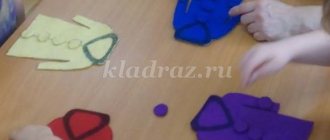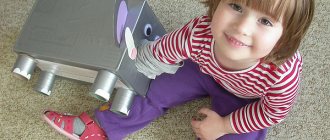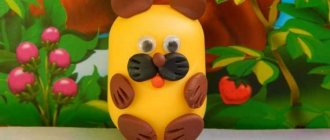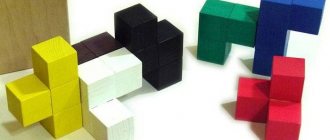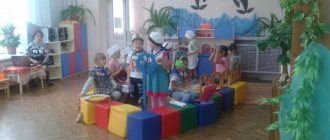Master classes for parents and pedagogical and methodological manuals on the topic
Master Class
for parents
"Unconventional finger games"
Prepared by:
teacher Kalinina I.A.
Goals:
— increase the competence of parents in matters of child speech development;
— explain to parents the need to perform exercises to develop fine motor skills;
— give recommendations for conducting non-traditional finger games;
— build emotional and trusting relationships that contribute to the full development of children and positive self-realization of adults.
Equipment: memos with recommendations for parents on the development of fine motor skills, buttons, trays and bags with bulk materials (peas, beans, buckwheat, semolina), clothespins and geometric shapes, bottle caps, containers with beads and pasta, “Magic boxes of matches, pine cones, walnuts, massage balls.
Parents with children sit at tables on which there are various objects: buttons, caps from plastic bottles, clothespins, “dry pools” - containers, deliveries of bulk materials, etc.
Progress of the master class:
Hello, dear parents, I am glad to see you at the master class. Today we will talk about non-traditional finger games.
First, I want to ask what finger games are for and what they develop (answers).
Finger games develop a child's brain, stimulate speech development, creativity and imagination. The better the fingers and the entire hand work, the better the child speaks. Research by scientists has shown that the speech development center actively interacts with the motor center of the brain. Therefore, if you want your child to speak well, develop his hands!
You need to start working on developing fine motor skills from a very early age. Already an infant can massage the fingers and toes, thereby influencing the active points associated with the cerebral cortex.
Recommendations for finger games:
- in order to interest the child and help him master new information, you need to turn learning into a game, and do not forget to praise the child;
- the main requirement in games with the hand, hand, and fingers is that we must take equal care of the development of the right and left hands, at first you can perform movements with each hand separately, then together;
— you can play with your fingers at home, away, on the street, in transport, in the sandbox, etc.;
- some non-traditional finger games with preschool children are carried out under the supervision of adults.
We bring to your attention non-traditional games for the development of fine motor skills, which can be practiced both in kindergarten and at home, both with the youngest children and with children of older preschool age.
Parents do the exercises with their children.
Games with buttons.
1.Choose buttons of different sizes and colors. Try to post a drawing of a ball; at home you can ask your child to make the same one. After the child learns to complete the task, invite him to come up with his own versions of the drawings. You can use a button mosaic to make a flower, a tumbler, a snowman, a butterfly, beads, etc.
2.Buttons can also be strung on a thread to make beads.
3. You can use buttons to make letters of the Russian alphabet in literacy classes.
Games with bulk materials.
1.Pour peas or beans into a container. The child puts his hands in there and pretends to knead the dough.
2.From the container, first transfer the beans into the jar with one hand. Then with both hands at the same time, alternately with the thumb and middle finger, thumb and ring finger, thumb and little finger.
3.Pour beans onto a saucer. We take a pea with our thumb and forefinger and hold it with the rest of our fingers, as if picking berries, then we take the next pea, then another and another - so we pick up a whole handful. You can do this with one or two hands.
4.Spread fine grains onto a bright tray in a thin, even layer. Let's run the child's finger along the rump. You will get a bright contrasting line. Let your child draw a few chaotic lines himself. Then try to draw some objects together (fence, rain, waves, letters, etc.).
5. Place peas or beans and toys from Kinder Surprises into the “dry pool” or bag. We ask the child to get all the toys. The child puts his hand into it and tries by touch to identify and get only the toy. The task can be complicated by mixing peas and beans in small quantities. We ask the child to get only the beans.
6.Pour the cereal into the bag, sew it up and let the child touch and mash it. The task can be complicated by asking the child to guess which cereal is in the bag, provided that he is familiar with them.
Games with bottle caps.
1. Place two caps from plastic bottles on the table with the threads facing up. These are “skis”. The index and middle fingers stand in them like feet. We move on “skis”, taking one step for each stressed syllable:
“In the fresh snow, we rush down the mountain,
We love the fun of cold winter."
You can try to do the same with both hands at the same time.
If you drill the plugs in the middle, you can also use them for stringing beads.
Games with clothespins
1.Take a clothespin and test it on your fingers to make sure it is not too tight. Then, using a clothespin, we alternately “bite” the nail phalanges (from the index to the little finger and back) on the stressed syllables of the verse:
“The baby kitten bites hard,
He thinks it's not a finger, but a mouse. (Change hands.)
But I'm playing with you, silly,
And if you bite, I’ll tell you: “Shoo!”
2.Imagine with your child that clothespins are small fish, and a square made of cardboard is a feeder. Well, the baby needs to help the fish eat lunch, that is, attach them around the perimeter of the figure. It is very interesting for children to make a sun, “attach needles” to a hedgehog cut out of cardboard, and more.
These games can keep your child busy for a long time. What seems so simple and uninteresting to us adults captivates the child and, at the same time, develops him.
Games with beads, pasta.
Various stringing exercises are excellent for developing the hand. You can string anything that can be strung: buttons, beads, horns and pasta, dryers. Beads and buttons can be sorted by size, color, shape.
Games with sticks and matches.
1. Invite the child to collect sticks (or counting sticks) using the same fingers of different hands: two index fingers, two middle fingers, two ring fingers, two little fingers.
2. Let’s build a “house” from matches, the higher and leveler the “house”, the better (adult shows a sample diagram).
Games with cones, walnuts and a massage ball.
1. We invite the child to roll a walnut, pine cone or massage ball between his palms.
2. The child holds two walnuts in one hand and rotates them around one another.
I really hope that I was able to convince you of the importance of hand development for a preschool child and that through joint efforts we will help our children train their hands and promote speech development.
List of used and recommended literature
1.Vygodskaya I.G., Berkovskaya N.V. Zvukograd, Bukvograd, Zlatoustia. M., 1999.
2. Krupenchuk O.I. Teach me to speak correctly. St. Petersburg, 2001.
3. Nishcheva N.V. System of correctional work in a speech therapy group for children with general speech underdevelopment. St. Petersburg, 2003.
4. Svetlova I. Developing fine motor skills and hand coordination. M., 2001.
5. Website https://www.maam.ru/detskijsad
